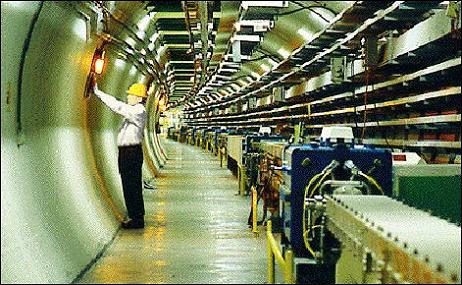Some scientists estimate that particle physics could allow us a glimpse into the future
Graham Collins, Scientific American

"It is very difficult to predict, and it is especially difficult to predict the future," said Niels Bohr, Nobel laureate, many years ago, and since then many have quoted him. About 150 senior physicists gathered about a year ago at the University of California in Santa Barbara to do this difficult job. At the conference, the participants looked back, at the last twenty-five years of physics in the last century, and looked forward, at what lay in the bosom of the future. What were they actually trying to achieve?
Although most of the speakers dealt with the theoretical side of the subject, there was one experimental facility that figured prominently in several lectures: the Large Hadron Collider (LHC) under construction at CERN, the European Center for Particle Physics in Geneva. The facility is scheduled to begin scientific operations around 2007. Several speakers expressed their expectation that the LHC will answer some of the outstanding questions in the Standard Model of particle physics, and what will come after it.
Greetings from the strings
Nima Archani-Hamed of Harvard University has suggested that the LHC could reveal evidence for much more unusual physics, such as the "landscape" of string theory, in which our universe is just a small part of a much larger multiverse, each of its divisions holding different values of The constants of physics. Archani-Hamed presented predictions that raise a new theoretical model dealing with the Higgs particle, a particle that, according to information, is responsible for the masses of the other elementary particles, and finding it is a primary goal for the LHC experiments.
This model posits that the mass of the Higgs boson is calibrated with great precision in our multiverse, and this would allow the predicted effects of supersymmetry to occur at much higher energies than many currently expect. This change will eliminate all the phenomenological problems of the accepted supersymmetry models, he claims, and will provide accurate predictions of what the LHC will see.
Steven Weinberg from the University of Texas at Austin shared with the listeners his "nightmare": the LHC will reveal only the simplest possible species of the Higgs particle, and will not discover anything that challenges the Standard Model. This will leave many questions unanswered, and provide very few clues as to the possible ways to expand the standard model.
On the low-energy side of physics, Steven Kivelson of the University of California, Los Angeles was one of those who spoke about condensed matter physics, which is essentially the study of the behavior of electrons within matter. According to him, the most pressing problem, which he hopes will be solved soon, is the so-called "bad metals". These materials exhibit phenomena that are very easy to describe, but cannot be explained according to any known physics of metals.
Looking ahead
Philip Anderson of Princeton University focused on the special case of high-temperature superconductors that are doped with a moderate amount of impurities, and operate at a temperature slightly above their transition temperature. "We should be terribly ashamed," he said, because the theory behind this situation remained without any solution.
The conference also dealt with many other fields, such as nanophysics, astrophysics (especially gravitational waves), quantum computing and gravity. He also held an impromptu celebration in honor of the Nobel laureates; One of the winners (2004) is the director of the institute, David Gross.
In summing up the conference, Gross presented 25 questions about the future, which encompassed the entire range of topics. The questions were selected from those suggested by the conference participants. Some of them concerned the application of physics to the life sciences. Is it possible to predict the shape of an organism by looking at its genome? Is it possible to put the theory of evolution on a quantitative basis that allows predictions? Is new mathematics necessary to understand biology, just as string theory requires new mathematics?
These questions reflect a trend that William Bialek, a biophysicist from Princeton University, was already addressing at the beginning of the conference. According to him, 25 years ago biophysics was concerned with the application of physical methods to problems presented by biologists, whereas today it stands for the new and difficult research questions presented by physicists about living matter. Perhaps the institute's fiftieth anniversary will be marked by discussions of a new type of theoretical biology, based on theoretical physics.
